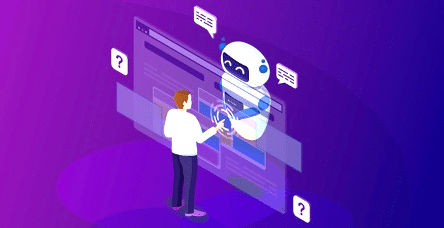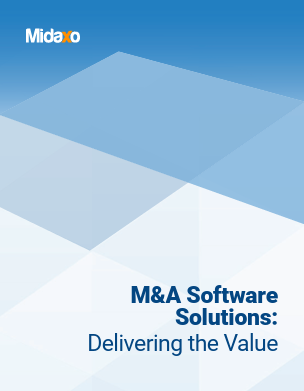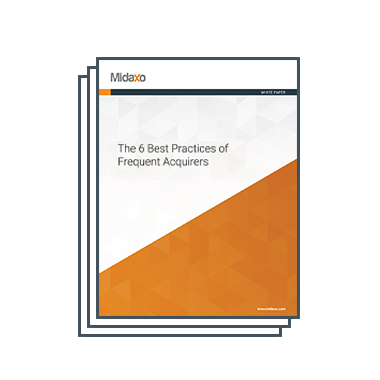The introduction of ChatGPT and GPT-4 marks a significant transformation in the way all types of ‘knowledge work’, including M&A and corporate development, will be carried out. As someone who has been thinking about how to develop specialized software for M&A every day for the last 10 years, I have never been more excited about a new addition to the industry.
The standard ChatGPT bot seems to do an impressive job brainstorming answers to high-level strategic questions as well as articulating best-practice approaches to achieve different strategies. For example, take the following prompt: “How could <company name> create value through M&A?”
Here’s what ChatGPT produced when asked such a question for Patagonia:
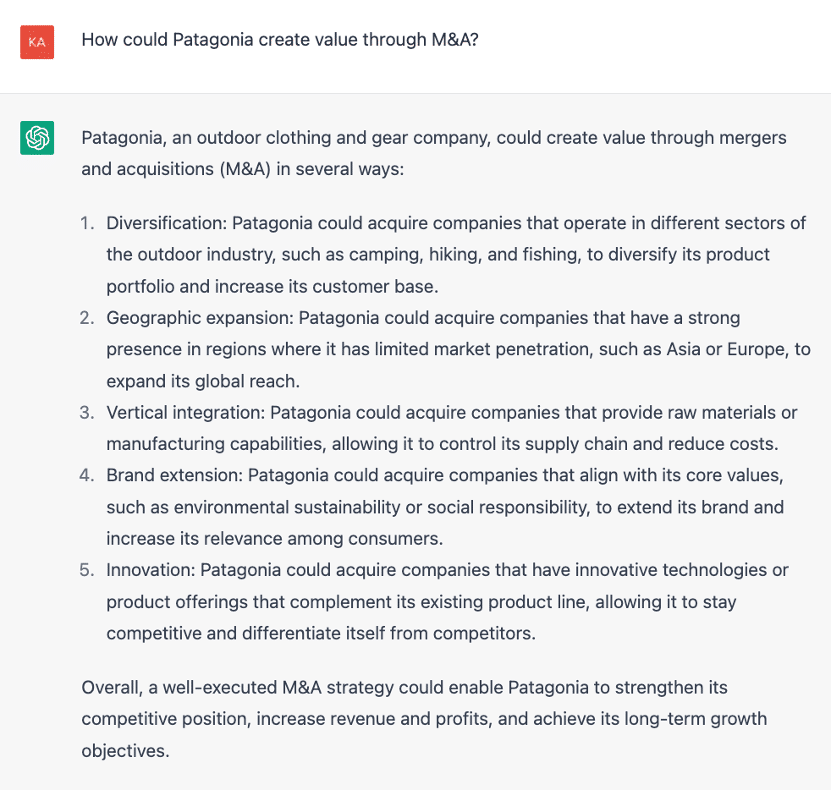
One can continue the ‘conversation’ with questions like: “What are some potential companies or sub-sectors within the outdoor industry that Patagonia could consider acquiring to diversity its product portfolio?” See the following response.
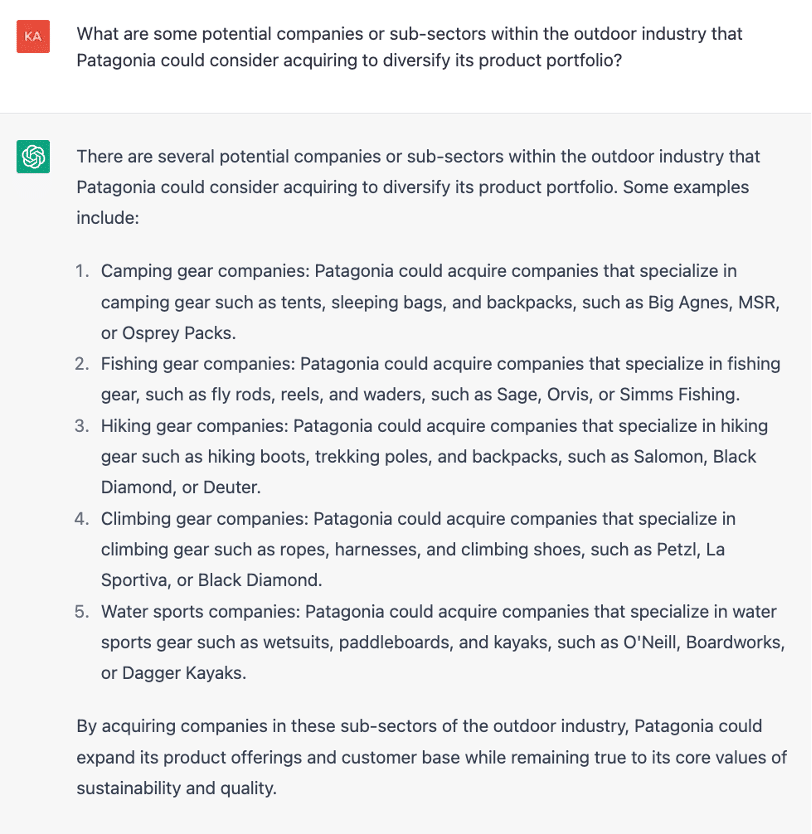
While these questions are quite basic and high-level, ChatGPT can go much deeper into the details of how to source deals, what to focus on during due diligence, or how to develop a deal thesis for a specific opportunity. AI bots like ChatGPT can also do part of the work in sourcing target companies per a company’s criteria, draft key deal documents, and so on. The caveat, of course, is one still must know what to ask the AI bot and how to parse its good ‘ideas’ from its bad ones.
AI Capabilities for M&A
You will notice ChatGPT will give you a generic or incomplete answer if you ask a broad question, like “What should the integration plan for my acquisition of Company X look like?”
This is because ChatGPT and other Large Language Models (LLMs) are designed to generate an answer to a question by approximating human responses to a prompt. They are not designed to go through a complex thinking process to develop an answer. This is why ChatGPT can sometimes generate plausible sounding but incorrect or nonsensical responses. The model basically gives you a response one word at a time, selecting the most likely word to come next in the sentence based on its training.
LLMs get their ‘intelligence’ from being trained on a massive amount of data — basically most of the public internet and a lot of books. Most of the M&A and corporate development content they have been trained on is descriptive: books, news articles, company web sites, sites like Wikipedia, or best practice guidance published by M&A consultants. There aren’t many examples of post-merger integration plans that the AI would have seen, but many of the concepts that go into a post-merger integration plan are described well in the content it has ‘read’. Therefore, if you are aware of its potential shortcomings and know how to handle input, AI can help draft a very solid integration plan. Learning how to prompt, then mold, analyze, and modify the rough output of a tool like ChatGPT can provide massive leverage in terms of turning intent into well-written M&A playbooks, due diligence checklists, and integration work plans.
The following questions could be helpful in constructing a quality integration plan using AI:
- What functional streams could the integration project be divided into?
- What are some key initiatives for each stream?
- What tasks go into realizing those initiatives?
Answers can also be tailored by including other factors in the prompt such as industry, company size, and deal rationale details.
Practical Challenges Using AI for M&A
Knowing how to ask an AI tool the right question is called prompt engineering. It is becoming a key skill for M&A practitioners, consultants, and M&A software engineers to master. It’s like upgrading from a bicycle to a motorcycle in terms of task completion speed. For example, if you want to list potential synergy drivers in a specific deal, prompting the AI to do it will yield a best practices-based draft within seconds. Instead of spending time and mental energy on coming up with the building blocks, you can focus on curating and improving the raw materials. With AI, work can be elevated to a higher level of abstraction.
Use of AI in a corporate development context is not restricted to general wisdom. It can be used to analyze or ask questions about existing documents or other proprietary content as well. For example, if you input a 10-page CEO update to the board of a target company, AI can summarize what was said about R&D progress and financial performance. While this functionality is not available in the standard ChatGPT tool, other software products can leverage AI technology to offer these outputs.
There are many things ChatGPT or other standard LLMs are not able to do on their own in order to enhance the M&A or corporate development processes. For example, storing confidential data, more complex deal sourcing, company monitoring, business case development, due diligence material analysis, and post-merger integration planning are all beyond the capabilities of the stock ChatGPT tool. However, M&A platforms can augment its capabilities to help perform these more complex tasks faster. In turn, AI will increase the ease-of-use and added value of purpose-built M&A platforms so much so that they will soon become a must-have for every serious corporate development team.
M&A consultants will also be able to provide their clients with more value through this technology. The standard of how M&A is done will improve as AI takes away much of the time-consuming, basic work of writing and reading documents, drafting project plans, etc. As less time is required to complete the necessities, more time can be devoted to value-creation activities. Both M&A consultants and platform providers also have proprietary data sets of best practices, historical information, and more that can be used to train more sophisticated AI models than what the general industry and agnostic models can provide.
The ChatGPT Era for M&A
In conclusion, companies participating in M&A will get massive value from this new AI technology in all phases of their process, from strategy definition to deal sourcing, business case development to due diligence, and post-merger integration. For more details on the possibilities, complete with examples, download Midaxo’s White Paper on AI in M&A.
Throughout history, major technical advances have resulted in more prosperity and better quality of life. It’s an exciting road ahead for M&A.
